
Drive Friendly: 4 Tips for Saving Money on Gas
With gas prices being as unpredictable as they have been, driving carefully to achieve better fuel efficiency has never been more prudent. Your first instinct might be to trade in your gas-powered, or internal combustion engine (ICE), car. However, before you ditch your beloved vehicle in favor of a Toyota Prius, you might consider modifying your driving habits. If you drive with these four tips in mind, you might end up saving money on gas.
1. Performing preventative maintenance can save you money in fuel and save the environment

Making sure your car is in tip-top shape is a great idea. Performing preventive maintenance and keeping up with your scheduled service intervals can prevent expensive repairs. Being proactive goes a long way. In addition to safeguarding your wallet and prolonging your car’s life, there are environmental benefits to being proactive.
According to the Environmental Protection Agency, replacing your spark plugs ahead of schedule can save up to $450.00 in fuel consumption. Also, replacing your air filter before it gets clogged will improve engine efficiency and cause fewer emissions.
2. Don’t drive angry, relax and save money on gas
Driving angrily or erratically can cause premature engine wear and excessive fuel consumption. First, abruptly starting and stopping causes undue harm to your vehicle’s brakes. That means that you may have to replace brake pads and warped rotors with greater frequency.
Also, unnecessary speeding causes the vehicle to consume more fuel rapidly, hurting your wallet and the environment. TrueCar reports that commuting with an average speed of 65 instead of 55 mph can cost upwards of $600 more in fuel per year.
3. Lose some weight; driving around with too much baggage can cost you gas money
It may seem self-explanatory, but keeping a car light makes it more efficient. That means getting into your trunk and back seat to clear the little things we carry without noticing. Keeping your car unburdened can improve fuel efficiency while starting, stopping, and cruising at highway speeds.
4. You might grow tired of all this pressure. Get it? Never mind, just check your tire pressure
One of the little upkeep measures that owners often overlook is ensuring that their tires are properly inflated. Many gas stations have free or pay-to-use air towers with a compressor and gauge built-in. However, while keeping your tires inflated is prudent, there are some benefits you may not realize.
First, the U.S. Department of Energy reports that for each pound per square inch (PSI) tires are below recommended pressure will reduce fuel efficiency by approximately 0.2%. While that may not seem like much, it may surprise you how it adds up. TrueCar says that owners can save up to $65 per year in gasoline at that rate. Finally, keeping your tires properly inflated will prolong the life of your tires and save you money on replacements.
Although these measures are designed to help with fuel economy, you might want to consider a plug-in hybrid electric vehicle (PHEV) or fully electric vehicle (EV)

While you can currently keep your gas-powered vehicle and drive more efficiently by following these tips, you might want to consider a change. Electric cars are getting more efficient and more reliable. Ranges for newer EVs are reaching past 300, 400, and even 500 miles. Also, for those not ready to commit to an EV, a PHEV can be an easier vehicle to own. PHEVs can be used for commuting and road trips without the unfortunate issue of range anxiety. Scroll down to the following article to read more about choosing between an EV and a gas-powered car.



